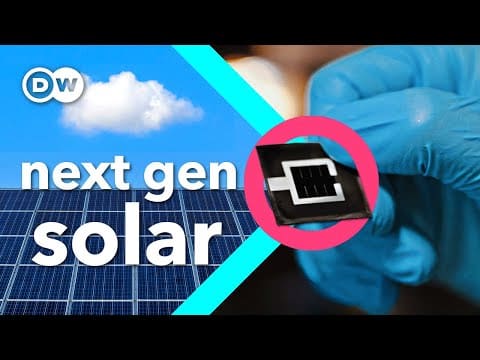Revolution in Solar Efficiency: The Rise of Perovskite Solar Cells
The Promise of Perovskite Solar Cells
The quest for more efficient solar energy has led to the development of a new type of solar cell made from a crystal structure known as perovskite. This emerging technology promises to revolutionize solar energy by offering several advantages over traditional silicon-based solar cells. Perovskite solar cells are not only more efficient but also easier to produce, potentially overcoming some of the significant barriers facing solar energy today.
Conventional silicon solar cells, the industry standard, convert only about 20 to 25% of sunlight into electricity and require high-energy processes for silicon purification. Perovskite solar cells, in contrast, can achieve higher efficiency levels and are synthesized from materials that are more abundant and less energy-intensive to process.
Understanding Perovskite Solar Cells
The term “perovskite” refers to a specific crystal structure denoted as ABX3, where ‘A’ and ‘X’ are ions of different sizes, and ‘B’ is a metal. One common formulation uses methylammonium, lead, and iodide. This structure can be easily synthesized, allowing for a variety of material combinations and straightforward production processes. The flexibility and ease of manufacturing perovskite cells offer a notable advantage over the intricate and costly production techniques required for silicon cells.
Research conducted at the Helmholtz-Zentrum in Berlin, under the leadership of Steve Albrecht, has significantly advanced our understanding of these materials. Albrecht’s team has been at the forefront of developing highly efficient perovskite solar cells, setting world records in the process.
The Innovation of Tandem Solar Cells
One of the most promising developments in perovskite solar cell technology is the creation of tandem solar cells. These cells layer perovskite and silicon to harness different parts of the solar spectrum more efficiently. The perovskite layer captures visible light, while the silicon layer absorbs the infrared spectrum. This dual-layer approach significantly enhances overall solar efficiency, enabling these cells to convert approximately 30% of sunlight into electricity. Theoretically, this method could increase sunlight conversion by up to 50% compared to traditional methods.
The Helmholtz-Zentrum utilizes a sun simulator to measure the efficiency of these tandem cells precisely, indicating nearly 30% efficiency in recent tests. This figure represents a substantial improvement over the maximum efficiency of single-junction solar cells.
Challenges to Commercialization
Despite the impressive advancements in perovskite solar cell technology, several challenges hinder their commercialization. The primary issue revolves around the stability of perovskite structures. These cells are vulnerable to degradation from environmental factors such as moisture, heat, and ultraviolet light, which can rapidly diminish their efficiency.
To address these stability concerns, researchers and companies are exploring various forms of encapsulation to protect the cells from external influences. This encapsulation is crucial for ensuring the longevity and effectiveness of perovskite solar cells in real-world applications. Notable companies like Qcells and Oxford PV are actively developing solutions, with Oxford PV claiming to have achieved a breakthrough in solving the degradation problem.
Economic Prospects and Market Viability
The economic viability of perovskite solar cells is also under scrutiny. To compete with the established silicon solar cells, perovskite cells must not only offer superior performance but also cost advantages. According to Jenny Chase of Bloomberg NEF, the cost per watt of solar energy needs to be competitive with current rates for widespread adoption. Since 2010, solar electricity costs have plummeted by 89% globally, presenting a challenging price target for new technologies like perovskite solar cells.
However, if companies can address both the cost and stability issues, the potential market for perovskite solar cells is enormous. Oxford PV, for instance, predicts that by 2024 it could begin shipping commercial-scale modules, with utility-scale solar parks expected to follow by 2026 or 2027.
Looking Ahead: The Future of Solar Energy
The development of perovskite and tandem solar cells represents a significant step forward in solar technology. With potential efficiencies exceeding those of traditional silicon cells, coupled with lower production costs and easier manufacturing, the future of solar energy looks promising. However, the transition from laboratory breakthroughs to commercial products will depend on overcoming significant technical and economic challenges. As this technology continues to evolve, it could play a crucial role in shaping the future of renewable energy, making solar power more accessible and efficient than ever before.








